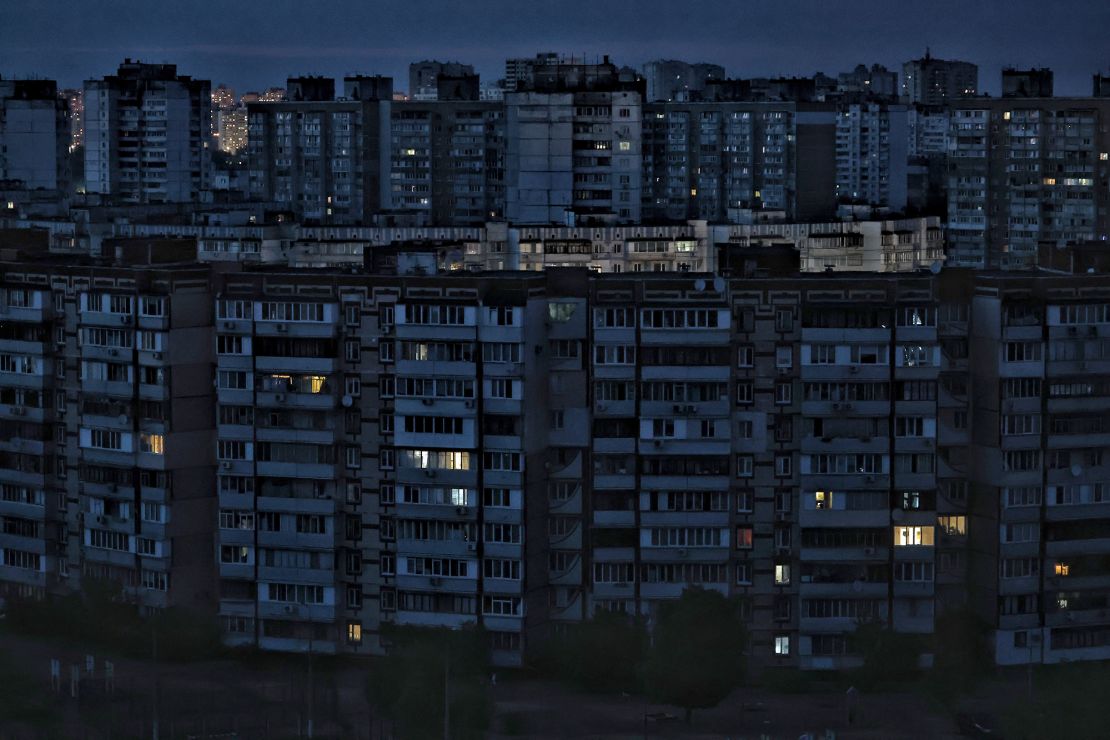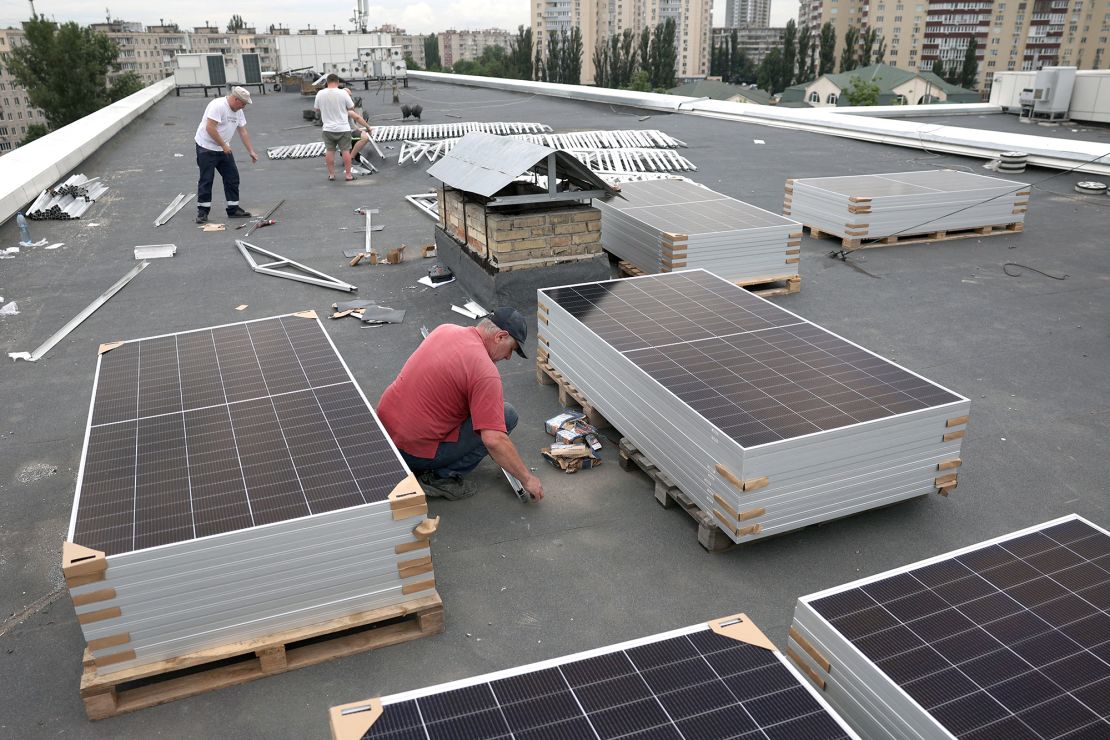Kyiv
CNN
—
Kateryna Serzhan says the one option to survive Ukraine’s virtually day by day blackout schedule is to “at all times have a plan B.”
The 35-year-old has needed to adapt to life in her high-rise Kyiv condo block together with her energetic 3-year-old daughter, Varia.
Going out to play includes mountain climbing again up 15 flights of stairs carrying her now 17 kg (37 lb) baby. They have an inclination to take a ball as a substitute of a bicycle for these days, she jokes.
With out energy, there’s no water, so she has to schedule her baby’s baths across the blackouts. However typically they happen outdoors of the scheduled occasions.
Eager to offer scorching meals every day to a toddler who doesn’t at all times eat them, she now has a fuel tenting range in her kitchen, and a small battery to energy the microwave.
Serzhan’s resilience masks a deepening disaster in Ukraine. These should not the primary rolling blackouts since Russia’s full-scale invasion, however they’re the primary to occur within the spring and early summer time – historically the months with lowest electrical energy demand earlier than air-conditioning season kicks in – underscoring the dimensions of the provision downside.
Within the early hours of Thursday morning, Ukraine endured the seventh huge Russian assault on its vitality amenities since March 22 this yr. Ukrenergo, the state-owned grid operator, reported harm in 4 areas. Seven vitality employees have been injured, and beforehand scheduled energy outages prolonged.
Ukraine’s vitality grid has been firmly within the crosshairs of Russian missiles for the reason that warfare started however this yr Moscow started particularly concentrating on energy era amenities – thermal energy vegetation, hydroelectric energy stations, even vitality storage amenities – a marked shift in techniques from the earlier winter, when the assaults have been much less exact, and the harm simpler to restore. Specialists say Russia has been utilizing higher weaponry and making the most of skinny Ukrainian air defenses.
At Ukraine’s reconstruction convention in Berlin in mid-June, President Volodymyr Zelensky laid out the dimensions of the destruction from the primary six assaults. “Russian missile and drone strikes have already destroyed 9 GW of capability, whereas the height vitality consumption in Ukraine final winter was 18 GW. So, half of it doesn’t exist anymore,” he stated.
Officers and vitality executives are actually acknowledging there isn’t any option to keep away from blackouts this winter. The mission now could be merely to reduce them.
“If we don’t restore the present the broken vegetation, if we don’t enhance the interconnector capability for enter, if we don’t construct these distributed mills, a minimum of in some locations… then folks can have energy for lower than 4 hours per day,” says Dmytro Sakharuk, government director of DTEK, Ukraine’s largest personal vitality firm.
“We now have 120 days left earlier than the beginning of the heating season,” he warns. “It can’t be enterprise as traditional.”


Ukraine is attempting to deal with the issue in a wide range of methods. In addition to rebuilding what they’ll, in some instances utilizing components from decommissioned energy vegetation in Europe, officers and vitality firms are attempting to safe as many mills and fuel generators as doable to assist vital infrastructure by way of the winter, and are working with European companions to extend imports of electrical energy.
Earlier than Russia’s full-scale invasion in February 2022, Ukraine was a web exporter of electrical energy, and had even been in a position to resume some exports throughout wartime. That stopped in March.
“We’re doing our greatest,” Deputy Power Minister Svitlana Grynchuk advised CNN. “We perceive that with out vitality it will likely be very tough to outlive.”
When supply-side efforts fall brief, all that’s left is to cut back demand. And which means asking for much more sacrifice from the already blackout-weary Ukrainian folks. “We requested our folks… to be prepared to know the state of affairs, to assist Ukraine, to assist our vitality employees,” says Grynchuk. “We name it the second entrance line, vitality.”
On the finish of April, a number of weeks after a Russian assault destroyed the Kyiv area’s greatest energy plant, Andrii Buzovskyi, a 52-year-old Kyiv police officer, spent about $1,400 on two photo voltaic panels for his balcony.
“I put in them in order that my household wouldn’t really feel uncomfortable when there isn’t any electrical energy,” he advised CNN. “What is going to occur subsequent is unknown.”
The federal government want to see extra of this. Ukraine’s Prime Minister Denis Shmyhal simply introduced new grants to assist housing cooperatives spend money on photo voltaic panels and warmth pumps. Ukraine’s central financial institution can be working to make loans for households and companies to purchase energy-related gear extra inexpensive.
In her Kyiv high-rise, Serzhan is pursuing a special sort of vitality independence. She is so fearful about braving freezing temperatures in her condo this winter, she’s seeking to hire a small home outdoors Kyiv with a wood-burning range.
“It’s just like the nineteenth century,” she admits.
Firms are doing their half. Ukrainian Railways has revised the schedule for 74 suburban trains (about 7% of the full), briefly suspending some companies. The corporate advised CNN it’s additionally halted using air con in administrative buildings, and turned off out of doors lighting.


The chief government of grocery store chain Auchan Ukraine, Marta Trush, advised CNN that whereas all its shops are already outfitted with mills, it has modernized its fridges to save lots of vitality and diminished its vary of merchandise with brief sell-by dates. A few of that has the added incentive of mitigating hovering prices.
“The operation of all the community on diesel mills is about 3 times dearer than from the central energy grid,” stated Trush. “So, to save lots of electrical energy within the gross sales areas, we scale back lighting and briefly prohibit entry to fridges, however we see how clients are understanding of the compelled measures.”
Energy outages have a transparent inflationary impact, stated Igor Piddubnyi, a researcher on the Kyiv College of Economics. “Firms need to need to one way or the other get back-up energy provide and they’re… shopping for the diesel mills, photo voltaic panels, etcetera…and it will increase the price of manufacturing,” he advised CNN. Ukraine’s incapability to export electrical energy additionally upsets its stability of commerce, he says, which feeds into inflation.
The Nationwide Financial institution of Ukraine estimated in Could that financial development will sluggish to three% this yr, from 5.3% in 2023, largely due to the harm to the vitality sector. Inflation is anticipated to rise barely to eight.2%.
And whereas Russia is experiencing a wartime uplift for its labor power, with unemployment at report lows, Piddubnyi stated proof exhibits energy outages are forcing Ukrainian firms to put off employees. The central financial institution nonetheless expects unemployment to fall this yr, however solely to 14% from the present stage of 15%.
It’s painful state of affairs, stated Piddubnyi. “Ukraine actually loses quite a bit, but in addition the issue is that Russia continues to be gathering big income from exporting oil and fuel.”
The Kyiv College of Economics estimated final month that rebuilding Ukraine’s broken vitality infrastructure would price $50.5 billion, factoring in new measures to enhance its resilience towards additional assaults. That’s the equal of all the hard-won mortgage backed by the income of frozen Russia property Ukraine was not too long ago promised, however it might not see that cash for months. The G7, having already spent $3bn thus far to assist Ukraine’s vitality sector, simply introduced one other $1bn in funding in early June.
And Piddubnyi factors out that calculating the true price of rebuilding, whereas assaults proceed, is not possible. “There’s a clear uncertainty of what number of extra energy vegetation will probably be destroyed by Russians,” he stated.
Ukraine’s vitality ministry says it has been constructing concrete shelters to guard some vitality gear from assaults. However extra superior air protection programs are the one option to shield total energy vegetation and forestall the reconstruction invoice from spiraling greater.
Within the wake of Thursday’s assault, Kyiv’s intensive lobbying efforts lastly appeared to be paying off. Romania agreed, after months of deliberation, to ship a Patriot air protection system to Ukraine. And a senior White Home official advised CNN that Ukraine was being given prime precedence for US shipments of superior air protection capabilities, forward of another international locations. These deliveries ought to begin this summer time.
Sakharuk, who spoke to CNN earlier than the seventh wave of strikes on vitality amenities on June 20, stated he want to see deliveries of air protection munitions particularly to guard vitality amenities.
He admits maintaining morale amongst workers is a serious problem. “They see that they’re in a sort of cycle the place they restore an vitality facility and Russia finds out that it’s being repaired, and (it’s) once more destroyed.”
“In some instances, the employees did this three to 4 occasions already.”
CNN’s Clare Sebastian wrote and reported from London, and Olga Voitovych reported from Kyiv. Svitlana Vlasova and Daria Tarasova-Markina contributed to this report.











